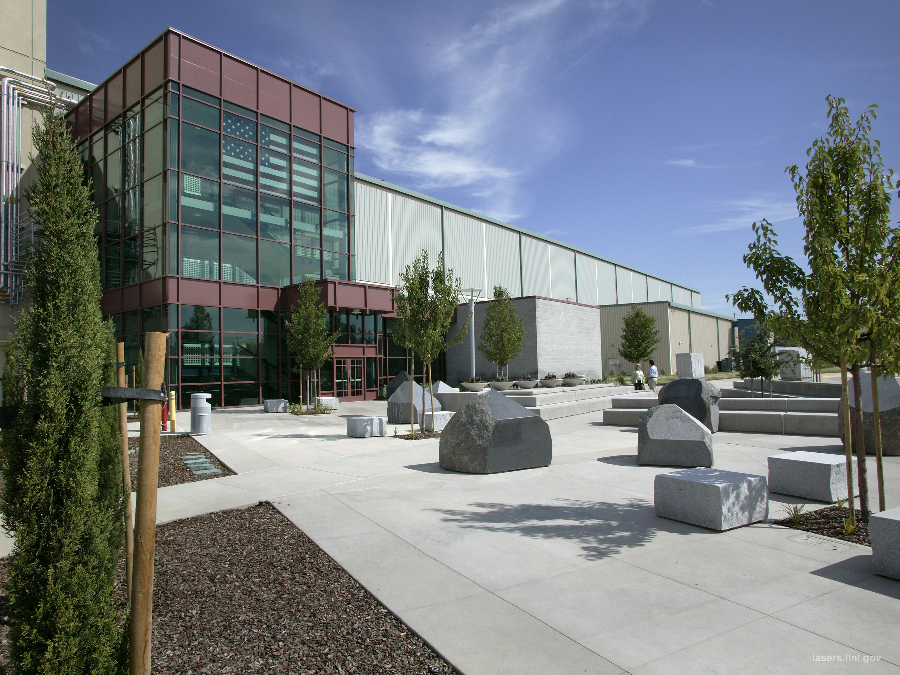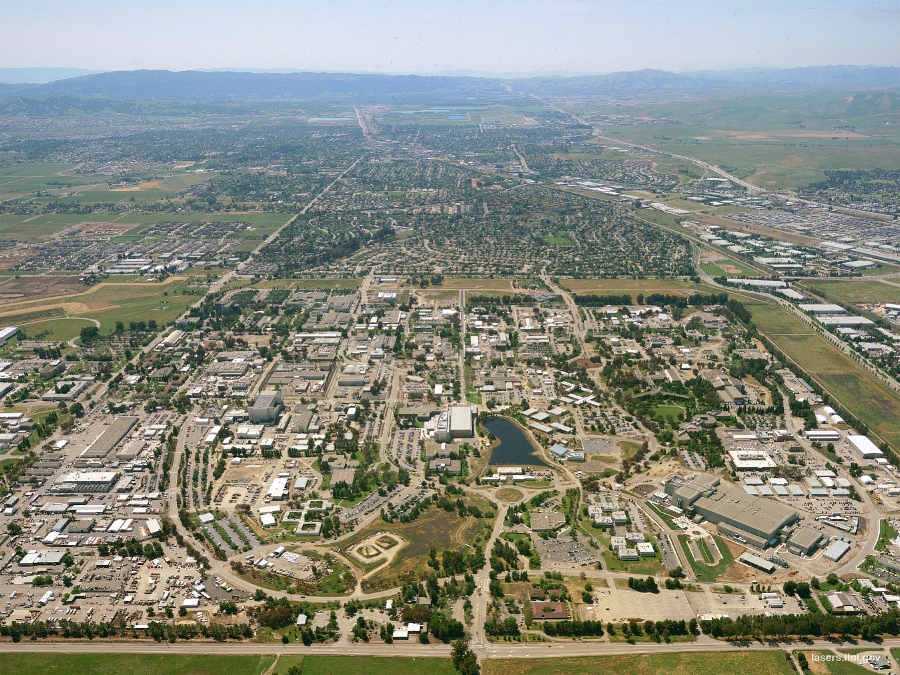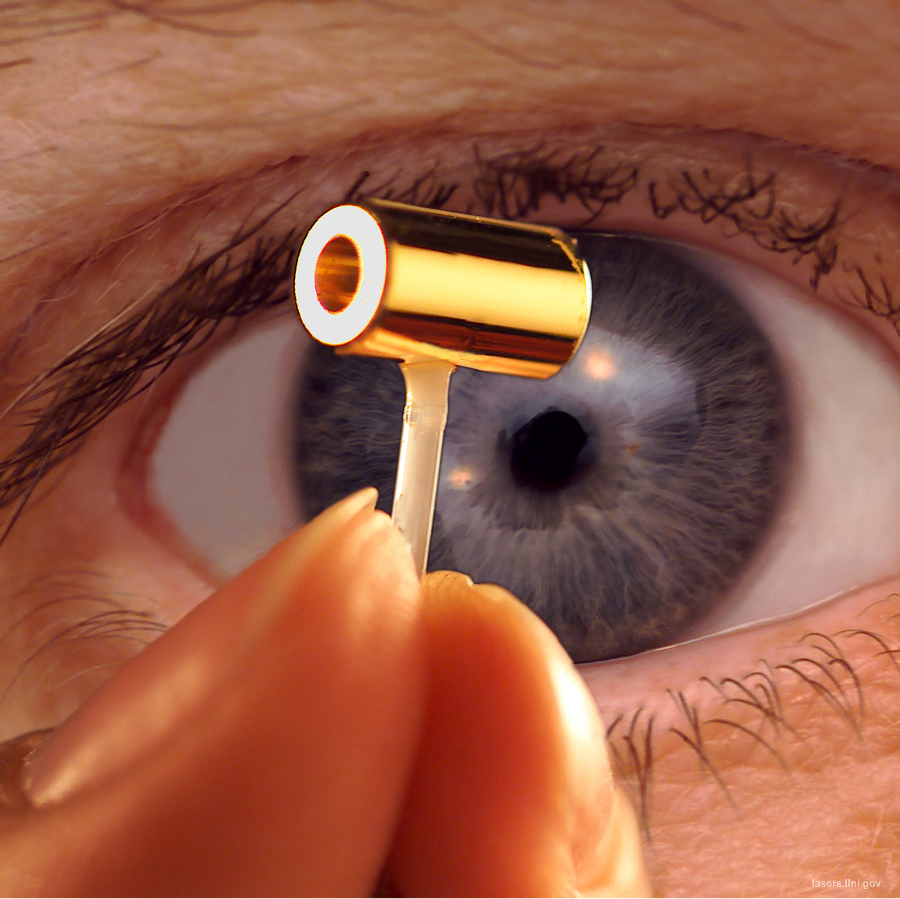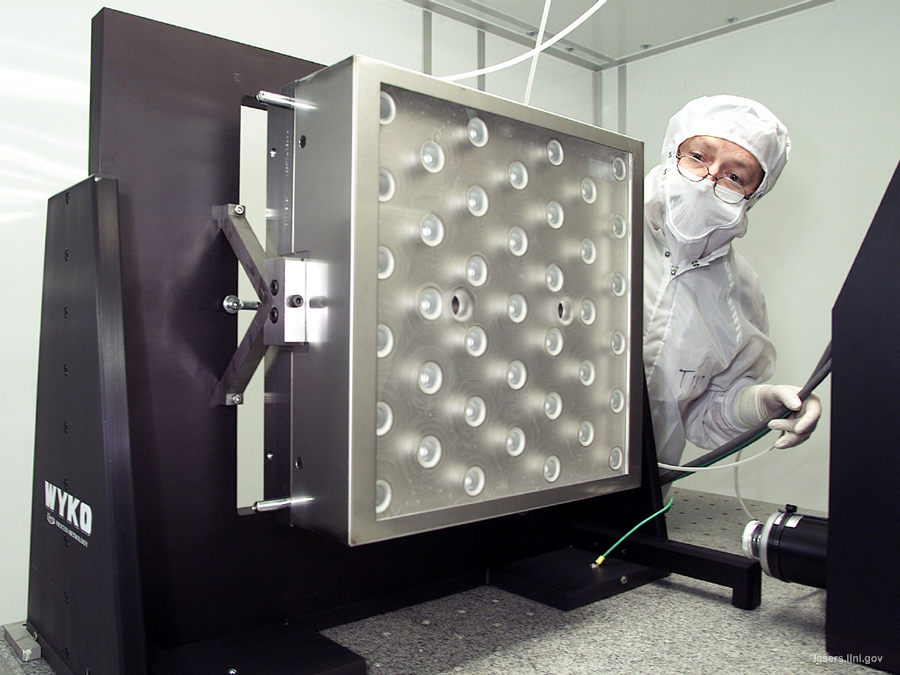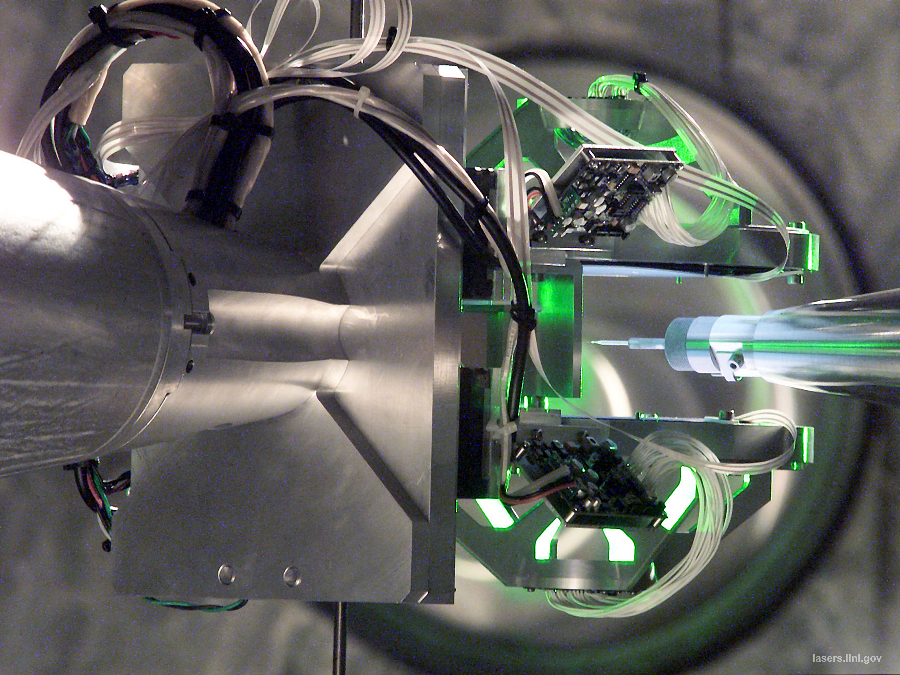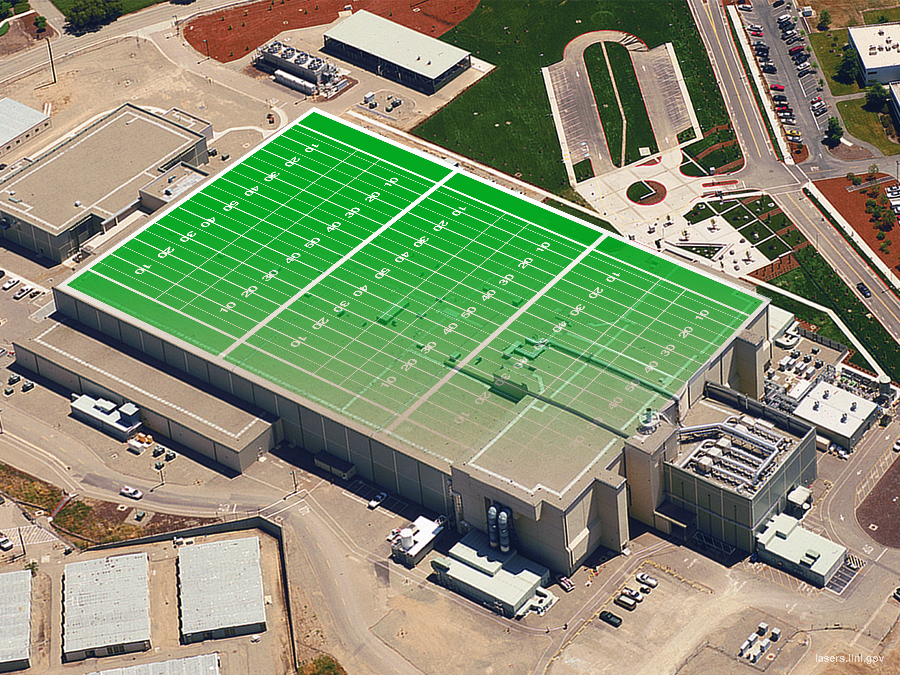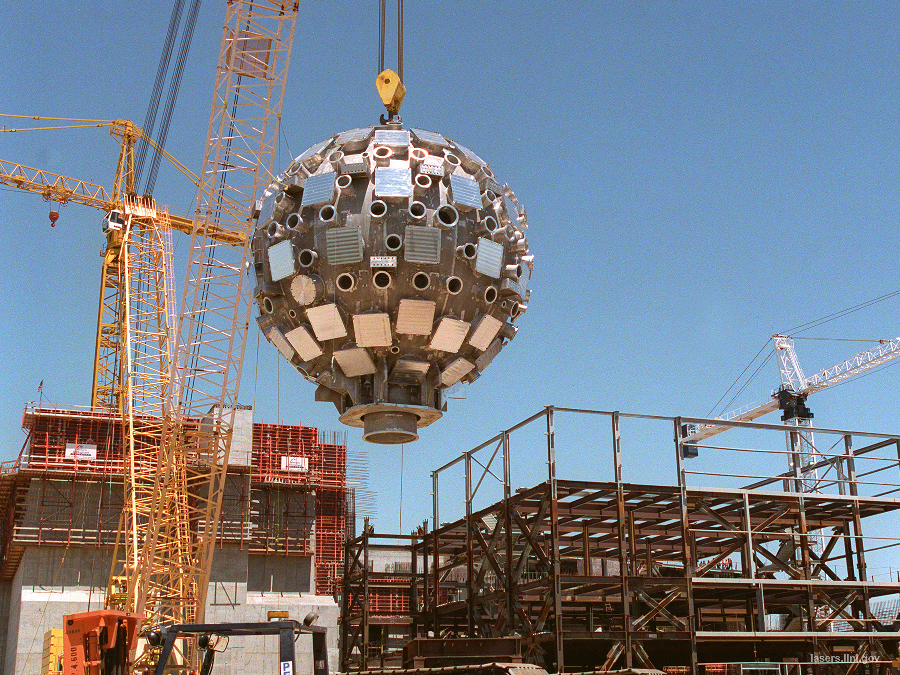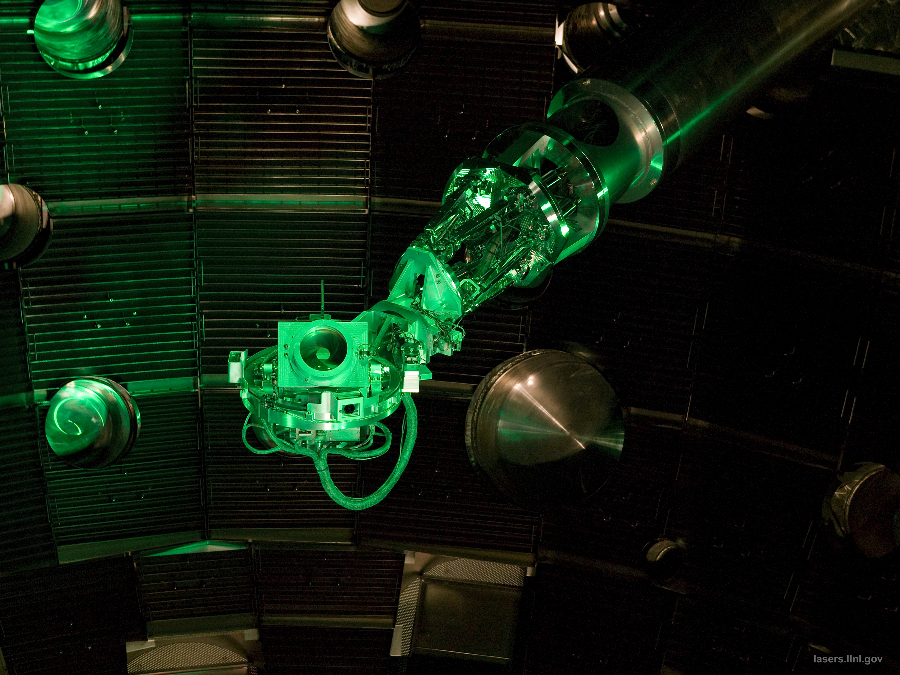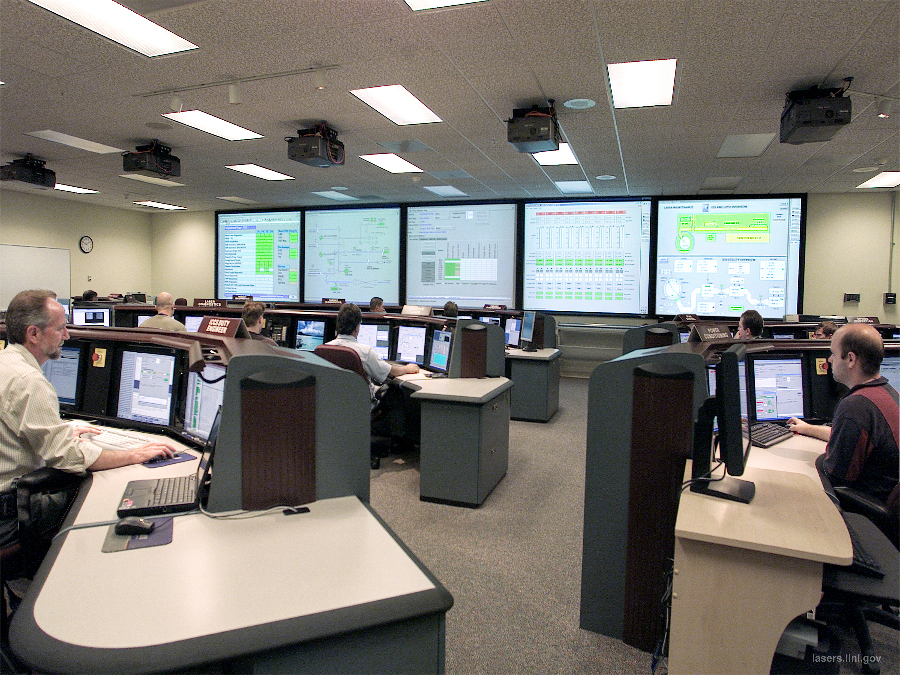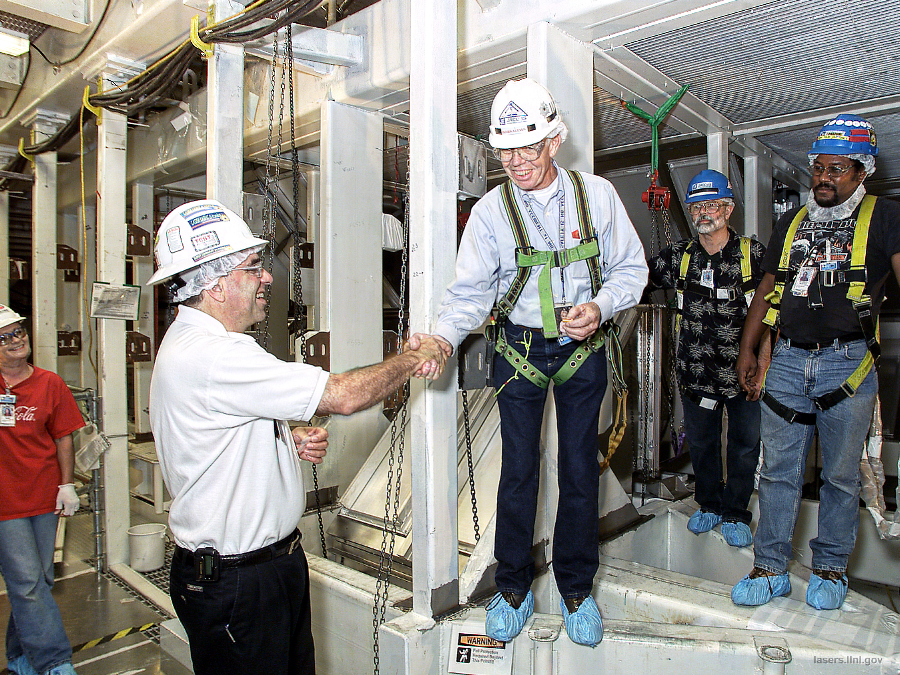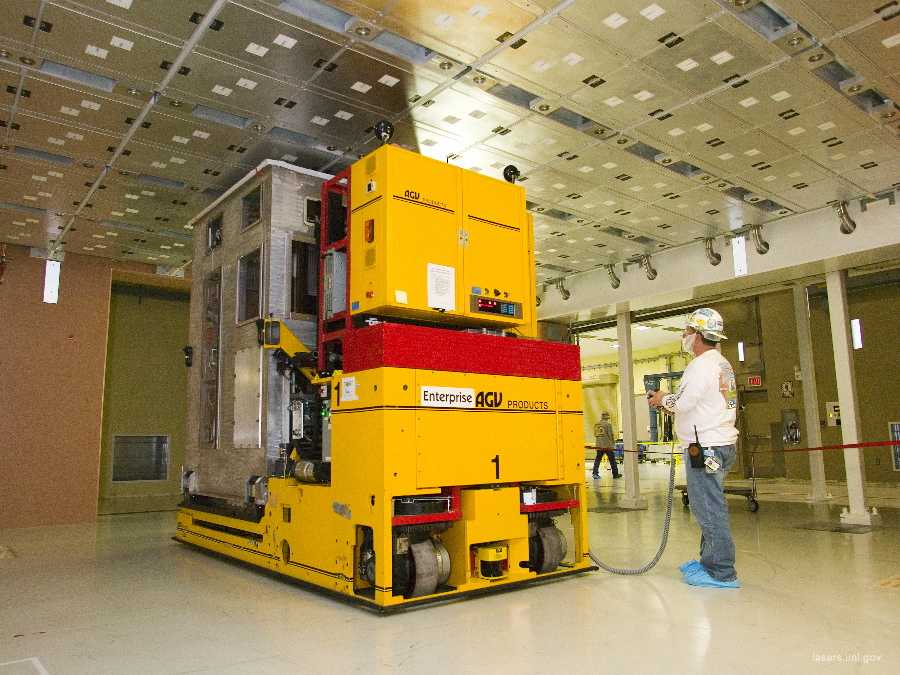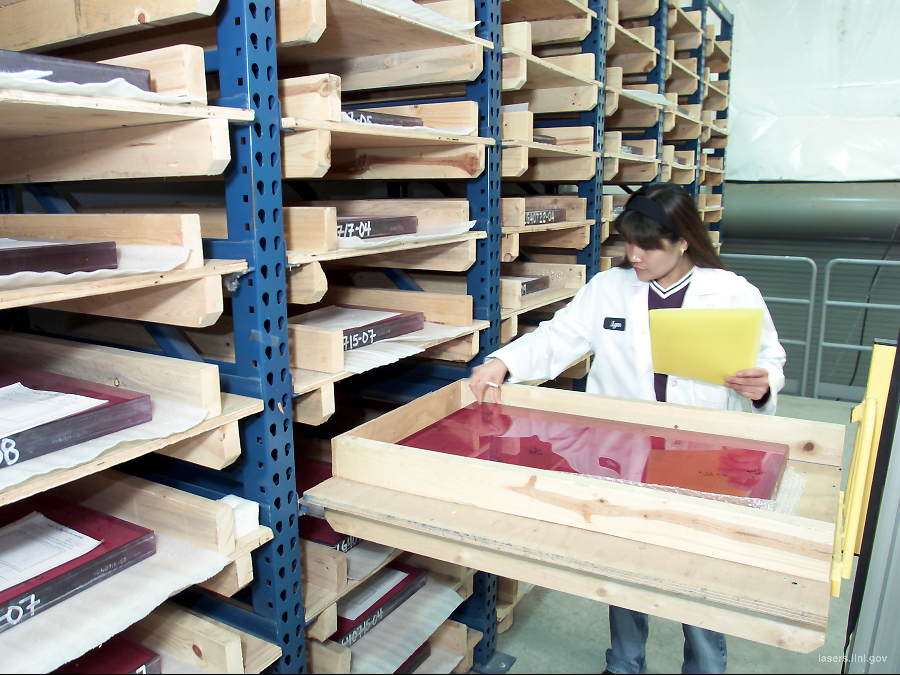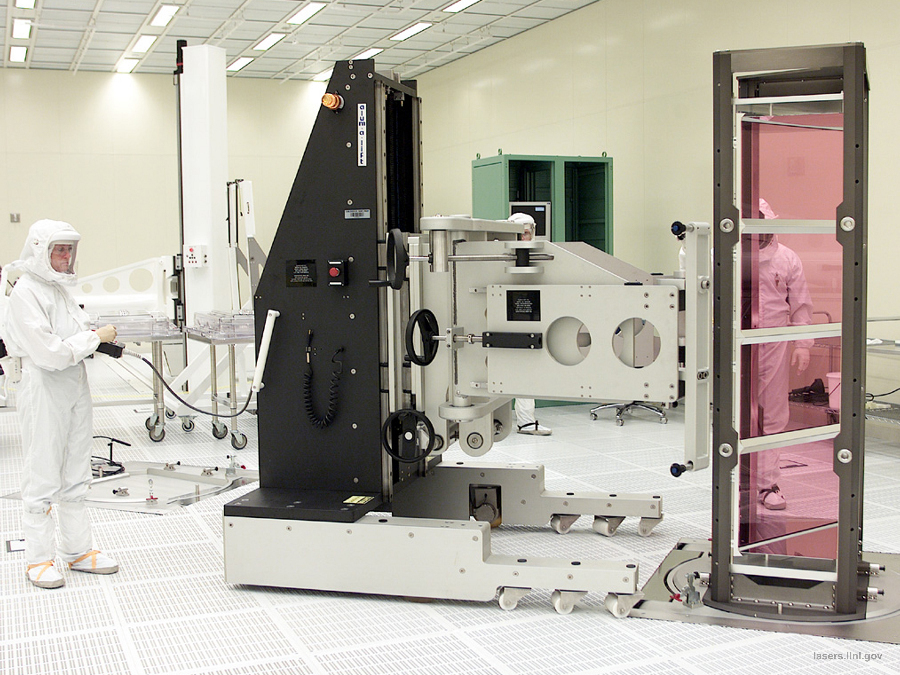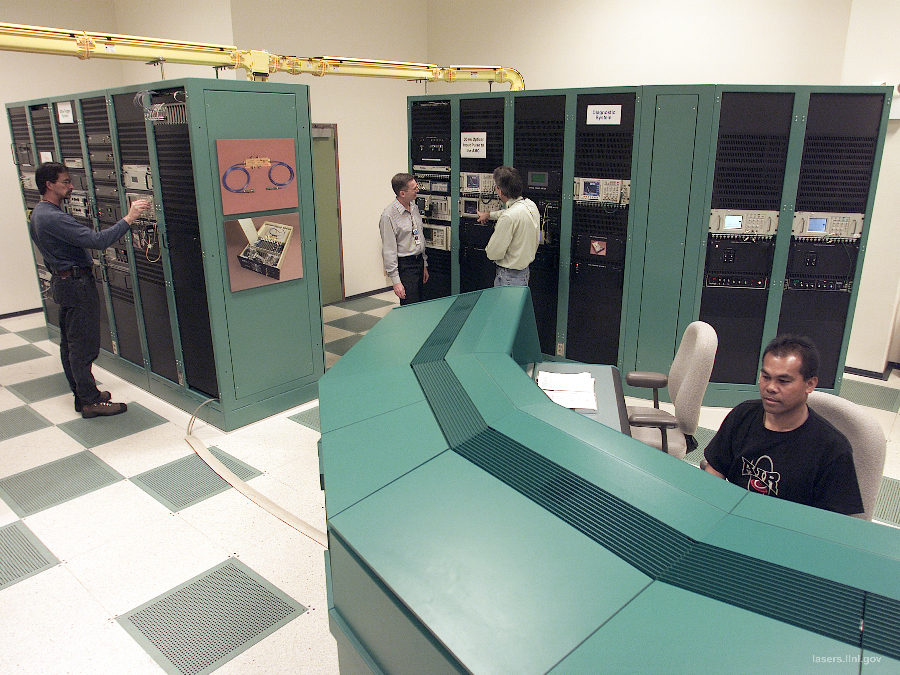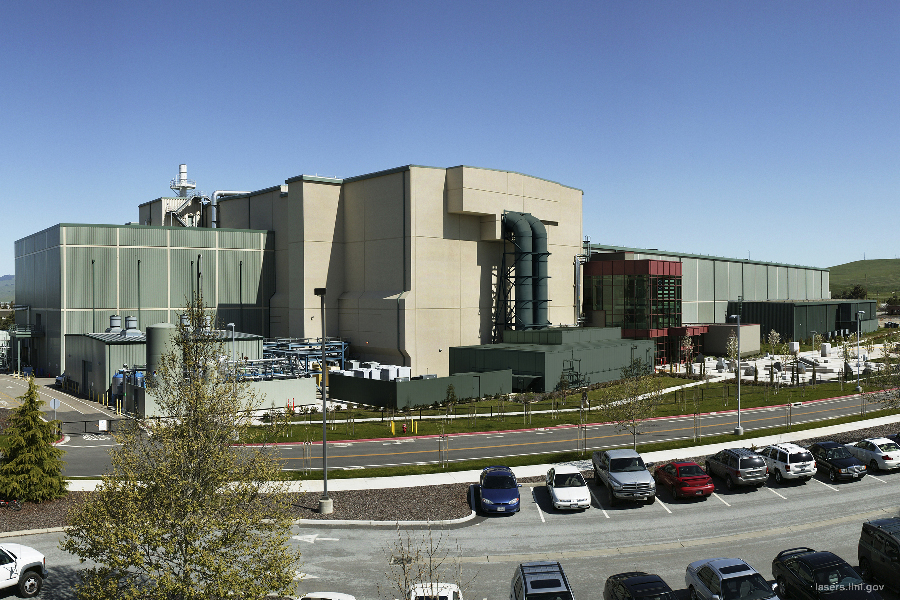Directed Energy Weapons
Project Shiva Nova
|
Creating a Miniature Star
on Earth
Photo Credit: National
Ignition Facility (NIF)
Most tours of NIF begin at the
Visitor Center, which showcases NIF technology and describes the overall
operation of the laser. Actual NIF optics and a 1/10 scale model of the
target chamber are on display here.
Creating a miniature star on
Earth: that's the goal of the National Ignition
Facility (NIF), the world's largest laser. When completed in 2009, NIF
will focus the intense energy of 192 giant laser beams on a BB-sized target
filled with hydrogen fuel – fusing, or igniting, the hydrogen atoms' nuclei.
This is the same fusion energy process that makes the stars shine and provides
the life-giving energy of the sun. NIF is a program of the U.S. Department
of Energy's National Nuclear Security Administration.
National Ignition
Facility (NIF) - SECURE SITE
Lawrence Livermore National
Laboratory • 7000 East Avenue • Livermore, CA 94550, Operated by Lawrence
Livermore National Security, LLC for the Department of Energy's National
Nuclear Security Administration
Inertial
Confinement Fusion: How to Make a Star - SECURE
SITE |
Photo Credit: National
Ignition Facility (NIF)
Lawrence Livermore National Laboratory
is located in Livermore, California, about 40 miles east of San Francisco
in southern Alameda County. The National Ignition Facility is in the northeast
corner of the Laboratory, at the bottom right corner in the photo.
Photo Credit: National
Ignition Facility (NIF)
A NIF hohlraum. The hohlraum
cylinder, which contains the NIF fusion fuel capsule, is just a few millimeters
wide, about the size of a pencil eraser, with beam entrance holes at either
end. The fuel capsule is the size of a small pea.
Photo Credit: National
Ignition Facility (NIF)
Deformable mirrors, located at
the ends of the NIF main amplifiers, use an array of 39 actuators to create
a movable surface that corrects aberrations in a beam due to minute distortions
in the optics.
Photo Credit: National
Ignition Facility (NIF)
Laser Bay 2, one of NIF's
two laser bays, was commissioned on July 31, 2007.
Photo Credit: National
Ignition Facility (NIF)
The interior of the NIF target
chamber. The louvered "first wall" protects the structure from possible
flying debris during shots. The target positioner, which holds the target,
is on the right.
Photo Credit: National
Ignition Facility (NIF)
The target positioner and target
alignment system precisely locate a target in the NIF target chamber. The
target is positioned with an accuracy of less than the thickness of a human
hair.
Photo Credit: National
Ignition Facility (NIF)
The fabrication of melted and
rough-cut blanks of laser glass amplifier slabs needed for NIF construction
(3,072 pieces) was completed in 2005. The amplifier slabs are neodymium-doped
phosphate glass manufactured by Hoya Corporation USA and Schott Glass Technologies.
Photo Credit: National
Ignition Facility (NIF)
The Laser and Target Area Building
is the size of three football fields.
Photo Credit: National
Ignition Facility (NIF)
This artist's rendering shows
a NIF target pellet inside a hohlraum capsule with laser beams entering
through openings on either end. The beams compress and heat the target
to the necessary conditions for nuclear fusion to occur. Ignition experiments
on NIF will be the culmination of more than 30 years of inertial confinement
fusion research and development, opening the door to exploration of previously
inaccessible physical regimes.
Photo Credit: National
Ignition Facility (NIF)
The 10-meter-diameter target
chamber, installed in June 1999, weighs 287,000 pounds. The spherical vacuum
vessel was assembled from 18 four-inch-thick aluminum sections fabricated
by Pitt-Des Moines, Inc., of Pittsburgh, Pennsylvania, and was installed
with one of the largest cranes in the world.
Photo Credit: National
Ignition Facility (NIF)
NIF's final optics inspection
system, when extended into the target chamber from a diagnostic instrument
manipulator, can produce images of all 192 beamline final optics assemblies.
Photo Credit: National
Ignition Facility (NIF)
The NIF Control Room. NIF's complex
operation, alignment and diagnostic functions are controlled and orchestrated
by the integrated computer control system. It consists of 300 front-end
processors attached to nearly 60,000 control points, including mirrors,
lenses, motors, sensors, cameras, amplifiers, capacitors and diagnostic
instruments. The shot director (left) must coordinate all 14 NIF subsystems
when preparing for a shot.
Photo Credit: National
Ignition Facility (NIF)
NIF & Photon Science Principal
Associate Director Ed Moses honors a NIF contract worker by presenting
him with the final "golden bolt" representing completion of the beampath
installation in Switchyard 1 in August 2003.
Photo Credit: National
Ignition Facility (NIF)
The laser bay transporter, an
automated guided vehicle, is used to install canisters containing amplifier
slab cassettes, known as line replaceable units, into the main amplifier
frame assembly units.
Photo Credit: National
Ignition Facility (NIF)
This potassium dihydrogen phosphate
(KDP) crystal, weighing almost 800 pounds, was produced through a newly
developed rapid-growth process that takes only two months, as opposed to
two years using conventional methods. Each crystal is sliced into 40-centimeter-square
crystal plates. More than 600 of these plates are needed for NIF.
Photo Credit: National
Ignition Facility (NIF)
In the summer of 2005, the fabrication
of melted and rough-cut blanks of amplifier slabs needed for NIF construction
(3,072 pieces) was completed. The amplifier slabs are neodymium-doped phosphate
glasses manufactured by Hoya Corporation USA and Schott Glass Technologies.
A novel, continuous melting process was used to make the meter-sized plates
of laser glass at a rate 20 times faster, five times cheaper, and with
two to three times better optical quality than with the previous one-at-a-time,
"discontinuous" process.
Photo Credit: National
Ignition Facility (NIF)
This is a laser glass slab in
a line replaceable unit (LRU) that was assembled in the Optics Assembly
Building cleanroom. An LRU is a large metal frame that holds various types
of lenses, mirrors or glass that can be easily installed in a beamline
or removed for maintenance. This glass slab LRU will be installed between
two flashlamp cassettes that fire as the laser beam passes through, causing
the beam to pick up energy from the specially treated glass on its way
to the target chamber.
Photo Credit: National
Ignition Facility (NIF)
NIF laser pulses are born in
the master oscillator room, in which a compact laser oscillator generates
low-energy (a few nanojoules) laser pulses. The oscillator pulse is shaped
in time and frequency-broadened, using the small range of multiple wavelengths
produced in the fiber laser, to help smooth the intensity of the laser
beam when it is ultimately focused on the target. There are 48 independent
pulse shaping systems, and each of the pulses is transported on separate
fiber optic cables to 48 preamplifier modules for further amplification.
Photo Credit: National
Ignition Facility (NIF)
In 2009, construction of the
National Ignition Facility will be complete. Experiments already will have
begun in support of the nation's nuclear weapon Stockpile Stewardship Program
as well as to study high energy density physics and astrophysical phenomena
and to begin laying the groundwork for fusion energy power production. |
| Clean Construction Protocol
for the National Ignition Facility Beampath and Utilities
Journal of the IEST
Issue: Volume 46, Number 1 / 2003
Pages: 85 - 97
Stanley C. Sommer A1, Irving F. Stowers A1, David E.
Van Doren A2
A1 Lawrence Livermore National Laboratory
A2 Jacobs Facilities Incorporated
Abstract:
When the stadium-size National Ignition Facility (NIF)
is fully operational at the Lawrence Livermore National Laboratory (LLNL),
its 192 laser beams will deliver 1.8 megajoules (500 terawatts) of energy
onto a target to create extremely high temperatures and pressures for inertial
confinement fusion research as part of the Stockpile Stewardship Program.
Due to the performance threshold and requirements of the NIF optical components,
the optics and their surrounding beampath as well as the supporting utility
systems must be fabricated, cleaned, assembled, and commissioned for precision
cleanliness. This paper will provide an overview of the NIF cleanliness
requirements, the Clean Construction Protocol (CCP) specifications for
the beampath and clean utilities, and techniques for verifying the CCP
specifications.
The NIF cleanliness requirements define limits for
molecular and particulate contamination. The goal of these limits is to
prevent contamination of optical components. To prevent laser-induced damage
and poor laser quality in the optical components, requirements for cleaning,
assembly, installation, and commissioning in terms of particle and nonvolatile
residue (NVR) levels are defined. The airborne cleanliness requirements
in the interior of the beampath are Class 1 (ISO Class 3) particulate levels
and a few parts-per-billion (ppb) airborne molecular contamination (AMC)
(SEMI F21-95 MC-1,000).
To achieve the cleanliness requirements for the beampath
interior, a graded CCP approach is used as the NIF beampath and utilities
are being constructed by a partnership between LLNL and the construction
contractor, Jacobs Facilities Inc. (JFI) in a stadium-size Class 100,000
(ISO Class 8) building. Installation of the beampath components utilizes
localized mini-environments of Class 100 (ISO Class 5) or better, with
budgets of cleanliness exposure or "class-hours" for each clean connection.
Garment, equipment, and operational considerations are evaluated with process
verification.
Verification of the beampath and utility cleanliness
is performed with cleanliness exposure monitoring, evaluating particulates
with "swipes" and the LLNL-developed Precision Cleanliness Verification
System (PCVS), and measuring nonvolatile residues (NVRs) and AMCs with
analytical chemistry techniques. Cleanliness verification results demonstrate
that the CCP specifications are achieving the NIF cleanliness requirements
for the beampath and clean utilities.
PDF Files
Clean
Construction Protocol for the National Ignition Facility Beampath and Utilities
- (Archived)
Sixth
Conference on Engineering Aspects of Lasers and Their Application
- (Archived)
V. V. Aleksandrov and V. Yu.
Baranov
Translated from Atomnaya Énergiya,
Vol. 44, No. 2, pp. 194–196, February, 1978
Shiva
Nova Organization - (Archived) |
| Empowering Light - Historic
Accomplishments in Laser Research
Excerpt...
In 1974, Livermore finished the one-beam, 10-joule
Janus laser and used it to conduct the first fusion experiments at the
Laboratory. It was used to demonstrate for the first time the thermonuclear
reaction in laser-imploded deuterium–tritium fuel capsules. Starting in
1974, the two-beam Janus laser was used to gain a better understanding
of laser–plasma physics and thermonuclear physics. It was also used to
improve the LASNEX computer code, a hydrodynamics code developed in the
1970s for laser fusion predictions, which is still in use today.
The one-beam Cyclops was also completed in 1974. Its
beamline was a prototype of the yet-to-be built Shiva laser.
..
From 1973 to 1977, the Laboratory
built four laser systems: (a) the one-beam Cyclops; (b) the one- and two-beam
Janus system, which is still in use; (c) the two-beam Argus; and (d) the
20-beam Shiva. Each new laser provided more power and better control over
the target-irradiation conditions as well as produced higher temperatures
and greater compression and density in the deuterium–tritium fuel than
its predecessor.
Excerpt...
The 20-beam Shiva became the world’s most powerful
laser in 1977, delivering 10.2 kilojoules of energy in less than a billionth
of a second in its first full-power firing. In June 1979, Shiva compressed
fusion fuel to a density of 50 to 100 times greater than its liquid density.
Even more important, according to John Holzrichter, who was responsible
for the laser and ICF programs at the time, Shiva proved once and for all
that infrared laser light was too long a wavelength to reach fusion energy
gain. Says Holzrichter, “The laser beam generates a dense plasma where
it impinges on the target material. The laser light gives up its energy
to the electrons in the plasma, which absorb the light. The rate at which
that happens depends on the wavelength and the intensity. On Shiva, we
were heating up electrons to incredible energies, but the targets were
not performing well. We tried a lot of stuff to coax the electrons to transfer
more of their energy to the target, with no success.”
...
This miniature “star”
was created in the Nova laser target chamber as 300 trillion watts of
power hit a 0.5-millimeter-diameter
target capsule containing deuterium–tritium fuel.
Excerpt...
Ten times more powerful than Shiva, Nova became the
world’s most powerful laser. In 1986, Nova produced the largest laser fusion
yield to date—a record 11 trillion fusion neutrons. The following year,
Nova compressed a fusion fuel target to about one-thirtieth of its original
diameter, close to that needed for ignition and fusion gain. In 1996, one
arm of Nova was reconfigured as a petawatt laser. (See S&TR, March
2000, The Amazing Power
of the Pettawatt; December 1996, Crossing
the Petawatt Threshold.) Record-setting laser shots produced pulses
with more than 1.3 quadrillion watts, or 1.3 petawatts, of peak power.
The laser pulse lasted less than 0.5 trillionth of a second—more than a
thousand times shorter than shots typically produced by Nova’s 10 beams.
Excerpt...
When the United States ceased
nuclear testing, laser facilities became even more important for defense
research, and the portion of Nova shots dedicated to the weapons program
increased considerably. Researchers using Nova continued obtaining high-energy-density
data necessary to validate the computer codes used to model nuclear weapons
physics.
SOURCE: Science &Technology
Review
September 2002 Empowering
Light - Historic Accomplishments in Laser Research
Ten times more powerful than
Shiva, Nova became the world’s most powerful laser. .....
Update:
Super Laser at the National
Ignition Facility - KQED QUEST
Youtube
Link
World's Most Powerful Laser Unveiled
Youtube
Link
The world's most powerful
laser was dedicated at the Livermore National Laboratory in California.
It's designed to shore up the nation's aging nuclear weapons. (May 29)
Related Articles
-
Energy & Technology Review
-
Science &Technology Review
-
September 1996, Taking
Lasers beyond the National Ignition Facility
-
November 1996, The
Secrets of Crystal Growth
-
December 1996, Crossing
the Petawatt Threshold
-
September 1998, The
X-Ray Laser: From Underground to Tabletop
-
October 1998, Blasts
of Light to Strengthen Metals
-
January/February 1999, Leading
the Best and the Brightest
-
July/August 1999, A
New View of the Universe
-
September 1999, Target
Chamber’s Dedication Marks a Giant Milestone
-
November 1999, Extreme
Ultraviolet Lithography–Imaging the Future
-
March 2000, The
Amazing Power of the Pettawatt
-
May 2000, Laser
Technology Follows in Lawrence’s Footsteps
-
September 2001, Lasershot
Makes Its Mark
-
November 2001, New
Targets for Inertial Fusion
-
April 2002, Bright
Future for Tactical Laser Weapons
-
May 2002, At
Livermore, Audacious Physics Has Thrived for 50 Years
-
June 2002, Adaptive
Optics Sharpen the View from Earth
-
September 2002 Empowering
Light - Historic Accomplishments in Laser Research
|
| FAIR USE NOTICE: This page contains copyrighted
material the use of which has not been specifically authorized by the copyright
owner. Pegasus Research Consortium distributes this material without profit
to those who have expressed a prior interest in receiving the included
information for research and educational purposes. We believe this constitutes
a fair use of any such copyrighted material as provided for in 17 U.S.C
§ 107. If you wish to use copyrighted material from this site for
purposes of your own that go beyond fair use, you must obtain permission
from the copyright owner. |
|
~ MENU ~
|
